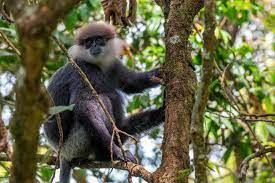Sri Lanka, a beautiful island nation situated in the Indian Ocean, is home to a wide variety of animal species. Among them, monkeys are some of the most fascinating and beloved creatures, with their playful and mischievous behavior, impressive acrobatic skills, and unique physical features.
There are several species of monkeys that can be found in Sri Lanka, each with its own characteristics, behavior, and habitat. In this article, we will explore all the monkeys that call Sri Lanka home.
________________________________________________________
- Toque Macaque (Macaca sinica)
The Toque Macaque is the most common monkey species in Sri Lanka and can be found in various habitats, including forests, urban areas, and sacred sites. They are small to medium-sized monkeys, weighing between 4-8 kg, with brown or grey fur and distinctive reddish-brown markings on their foreheads. Toque Macaques are highly social and live in large troops, usually led by dominant females.

________________________________________________________
- Purple-faced Langur (Semnopithecus vetulus)
The Purple-faced Langur, also known as the purple-faced leaf monkey, is an endemic species to Sri Lanka, found only in the country’s southern and western regions. As their name suggests, they have a distinct purple hue on their faces, with dark brown fur on their bodies. They are mainly herbivorous, feeding on leaves, fruits, and flowers, and can be found in groups of up to 30 individuals.

________________________________________________________
- Grey Langur (Semnopithecus priam)
The Grey Langur, also known as the Hanuman Langur, is a species of Old World monkey that can be found throughout South Asia, including Sri Lanka. They are larger than other monkey species in Sri Lanka, with males weighing up to 20 kg. They have long, grey fur and a distinctive pink face, and can be found in troops of up to 40 individuals.

________________________________________________________
- Toque Macaque (Macaca sinica aurifrons)
The Golden-fronted Toque Macaque, also known as the Golden Monkey, is a subspecies of the Toque Macaque found only in the dry zone of Sri Lanka. They have a distinctive golden or yellowish-brown forehead, with greyish-brown fur on their bodies. Golden-fronted Toque Macaques are highly social and live in large troops, with females being the dominant members.

________________________________________________________
- Rhesus Macaque (Macaca mulatta)
The Rhesus Macaque is a common monkey species found in many parts of South Asia, including Sri Lanka. They are medium-sized monkeys, weighing between 5-10 kg, with brownish-grey fur and a distinctive pink face. Rhesus Macaques are highly adaptable and can be found in a variety of habitats, including forests, urban areas, and agricultural fields.

________________________________________________________
- Bonnet Macaque (Macaca radiata)
The Bonnet Macaque, also known as the zati, is a species of Old World monkey found in many parts of South Asia, including Sri Lanka. They have distinctive cap-like hair on their head, which gives them their name. Bonnet Macaques are highly social and live in large troops, with females being the dominant members.

________________________________________________________
In addition to the six monkey species mentioned above, there are also some hybrid macaque species that can be found in Sri Lanka. These are the Rhesus-Macaque/Toque-Macaque hybrid and the Rhesus-Macaque/Bonnet-Macaque hybrid.
________________________________________________________
While monkeys are fascinating and entertaining creatures, it’s important to remember that they are wild animals and should be treated with caution and respect.
Feeding or approaching monkeys can be dangerous for both humans and the animals themselves. As such, it’s important to observe monkeys from a safe distance and avoid any direct contact with them.
It’s also crucial to not disturb their natural habitat or food sources. The destruction of forests and other natural habitats can have severe consequences for monkey populations and their survival. Conservation efforts, including education and awareness, are essential in ensuring the long-term survival of these fascinating animals in Sri Lanka. By respecting and appreciating these animals, we can help to protect their future in the wild.
